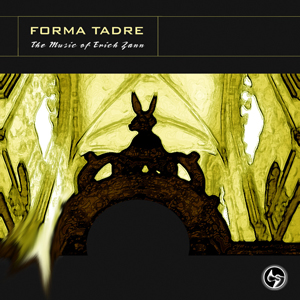
Title: The Music of Erich Zann
Artist: Forma Tadre
Genre: Electronic
Release Date: 19th January 2008
Label: None (Digital Release)
Introduction
The history of FORMA TADRE dates back to the late 80s, when the project was formed as a trio, consisting of Erwin Thom, Hansjoerg Schifferer and Andreas Meyer. Thom already left the band in the same year and Meyer and Schifferer continued the project as a duo. The years passed and the duo produced one song after the other but didn’t send a single demo tape to a label. When Andreas Meyer moved to Bielefeld, he decided to release the song ‘Plasmasleep’ o a tape compilation. This was also the moment where Daniel Myer and Andreas first met which resulted in the project NEWT. A bit later Meyer and Schifferer split up due to artistic differences. In 1996 ‘Navigator’, the first full-length album of FORMA TADRE, was finally released by the German label Off Beat and later also in the US via Metropolis Records. In 1998 ‘Automate’ was released and became an update with Automate 2.0 containing all the original tracks (including a completely rewritten version of the track Automate) and five additional tracks. ‘The Music of Erich Zann’ - inspired by the short story from H.P. Lovecraft - is the first official release of FORMA TADRE since 8 years.
Members
Andreas Meyer - Composing, Arrangements, Vocals, Lyrics
Website
http://www.formatadre.com/ / http://www.myspace.com/formatadre
Track Review
01. Prologue - 2:38
At first you will only hear a haunting and weird violin play gradually coming out and fading back into the darkness, what already builds up a certain tension but then just for a moment sounds swell up to an orchestral intensity, just to disappear seconds later leaving behind only the ghostly play of a flute, then violin come back to get louder and louder followed by a church organ culminating up to an orchestral ‘breakout’.
02. The Ascent - 6:37
Surrounded by indefinable noises, tapping steps coming from the left sounding like a person is moving up some stairs and that is no wonder as several places at the Rue d’Auseil consist of traps and it is also very steep almost like a cliff and very narrow. Soon you’ll get aware of a sustained tone. Some spherical melodic fragments appear and fly above the scenery and suddenly one thinks to hear rats scampering past you across the street. Then a beat announces itself. A very edgy beat and a complex arrangement with lots of layers and a bit of noise. Guess I’m missing plenty of details but that should already give you a good impression what’s expecting you.
03. Out of the Spirit World - 4:24
The track already starts out very melodic with alienated melody riffs reminding me a bit of a C64. Suddenly they stop and give way to a light viol arrangement and spherical tunes. Now we’re getting to what I like so much about this track. The orchestral arrangements which are sounding so good, that you get the feeling to listen to a real orchestra. These orchestral parts always alternate with calmer ones, where the playful electronic rhythms and spherical melodies dominate.
04. Across a Dark River - 5:01
I would rather call this a soundscape than an actual song. It creates images or sceneries in your mind. If I close my eyes, when listening to it, I’m seeing myself looking upon a dark river slowly flowing and sometimes a cold wind waves over it and crimps its surface. From far away whispering voices I don’t understand reach my ears. A bridge spans across the river and you always hear tapping steps getting closer and departing surrounded by what I think are processed piano sounds.
05. The German Viol Player - 3:46
The only song on the album actually featuring lyrics told out of the perspective of the viol player Erich Zann himself who’s pleading to the other gods to give him some rest and that he has not the wish to fight but his pleadings will not be heard and they will return every night anew. The intro sequence sounds as though you would listen to it in different rooms with different acoustics. When the beat sets in the chant starts right away. It’s very restrained and is closer to a whispering. The beat which is full of little electronic gadgets also has some sound that doesn’t seem to be electronically generated. At least it sounds pretty organic to me. Between the single verses a synth violin appears. Over all this a sustained synth layer impends giving the song even more depth and changing its pitch from time to time.
06. Antiquities - 1:38
At first I thought it was just a myriad of bells changing their rhythm and tempo for several time but now I’m not so sure anymore because I think to hear a xylophone as well. Either way it’s genius. A deep string layer appears after some time together with a flute
07. Litany - 2:13
A track arranged with classical means and I mean classical or should I say orchestral. It is built up very dynamic with very dramatic passages. At first ‘only’ some beautifully layered violin passages radiating a feeling of melancholy. Male and female choirs join in making the sound even more intense to swell up to a short moment of orchestral force where even trumpets get audible.
08. Physical but Mental - 3:09
…starts right away without an intro. The beats truly deserve the name ‘Industrial’ with their metallic sound you really get the impression of standing at a factory listening to how the workers treat the metal. Joining the beat are different choirs giving the sound a quite creepy atmosphere while varied sounds swirl around your head.
09. The Keyhole - 2:45
In front of us a micro cosmos full of spherical sounds opens up. The sounds seem to hover through this cosmos; rebounding on walls we are not able to see creating e very dense ambience. For a short length of time they’re stepping into the background and a cold wind takes over before they slowly fade in again
10. The Music of Erich Zann - 3:11
Creepy and unfamiliar noises appear and then it sounds like a machine has been started before everything stops and a sustained synth layer are taking us far away. Now and then voices ringing out of the darkness. We hear a clicking and suddenly the scenery changes. It feels like sitting in an old movie theatre watching a silent movie and we hear the clicking of the projector, while a piano player who accompanies the movie with a haunting melody.
11. Opposing Forces - 4:38
…tears us out of those dreamy spheres by starting with pretty complex beat very abruptly. A wind howls through the room. But this is only the basis for a play of multi faceted dreams. Some of them really sounding very gloomy All carefully and precisely arranged and layered. It fascinates more with every listen.
12. The Blackness of Space - 6:35
“Yet when I looked from that highest of all gable windows, looked while the candles sputtered and the insane viol howled with the night-wind, I saw no city spread below, and no friendly lights gleamed from remembered streets, but only the blackness of space illimitable; unimagined space alive with motion and music, and having no semblance of anything on earth.” A small quote from the original short story of H.P. Lovecraft this album is inspired by. This scenery has been perfectly captured and transformed into music. It’s like you would watch upon this impervious blackness from that gable window yourself and sounds of the most different kind would leave it. It’s more intense if you close your eyes while listening to it.
13. Final Sheet - 4:14
The first part of the finale is clearly dominated by more experimental structure if you can actually call that a structure in the proper sense of the word. What makes this part so fascinating is the lack of structure, the deviation from the standard. Slowly an eerie murk replaces the experimental parts and ambient-like atmospheres take control. Various extended synth layers, strings and piano sounds make this a worthy conclusion for this album.
Cover Picture

Rating
Music: 10
Sound: 10
Extras: -
Total: 10
Conclusion
As I’m a fan of Lovecraft and knew FORMA TADRE I was curious how a soundtrack album inspired by a short story from this great author would sound and I can say even without the use of vocals except for ‘The German Viol Player’ that this is incredible. Atmospheres get skillfully interweaved with each other and mixed with a variety of sounds. Strings are carefully arranged and layered and formed to little works of art. After eight years of silence Andreas Meyer aka Forma Tadre finally returns with a masterpiece in the still young year 2008. This album is available as a digital release only at ITunes and the Grenzwellen Shop as far as I know.
{jos_sb_discuss:19}






Comments powered by CComment